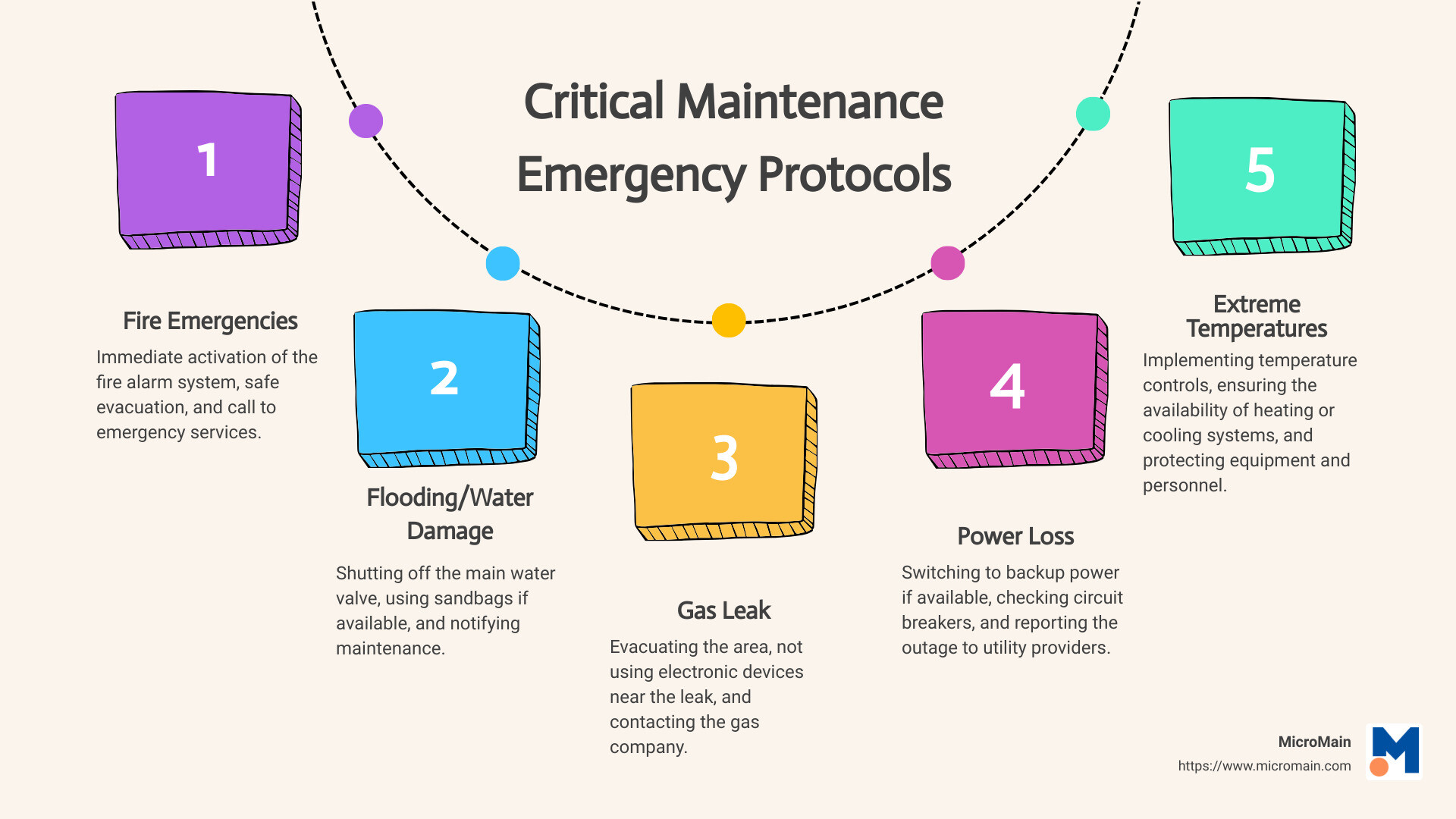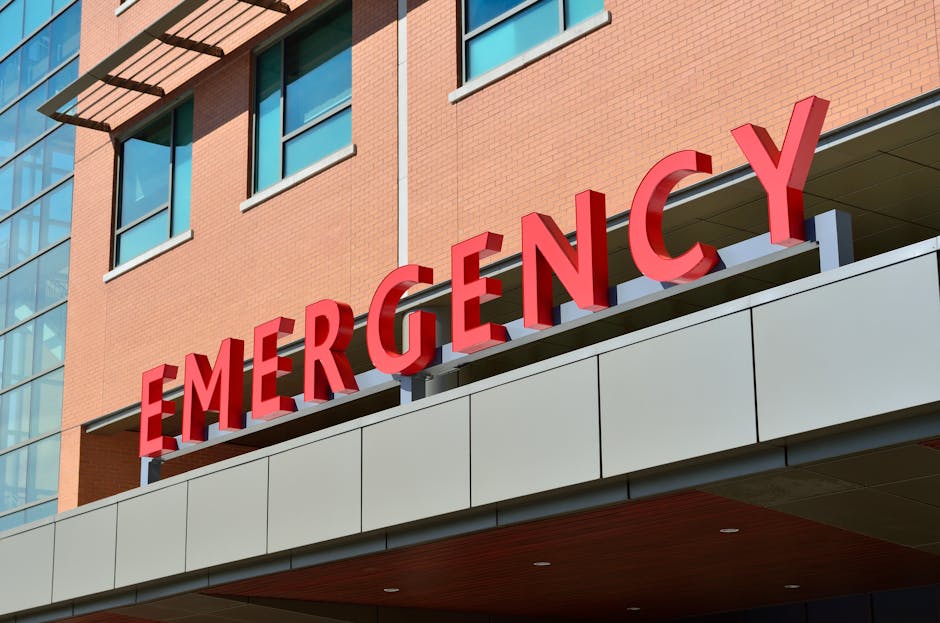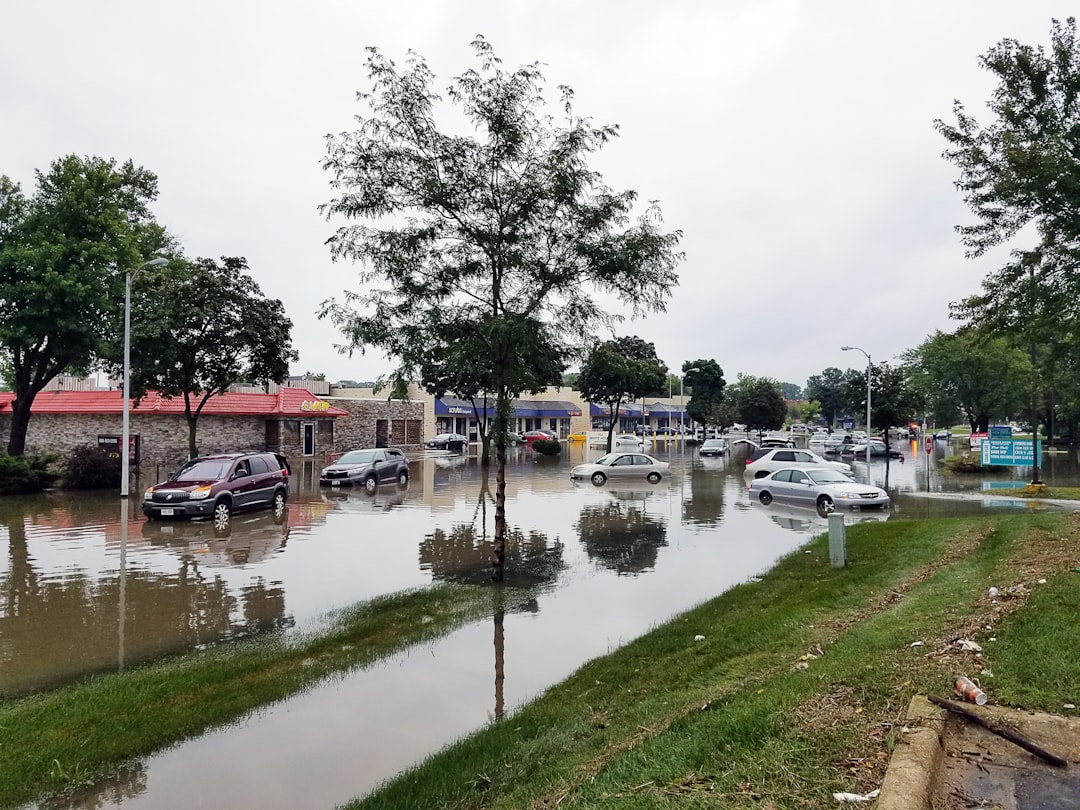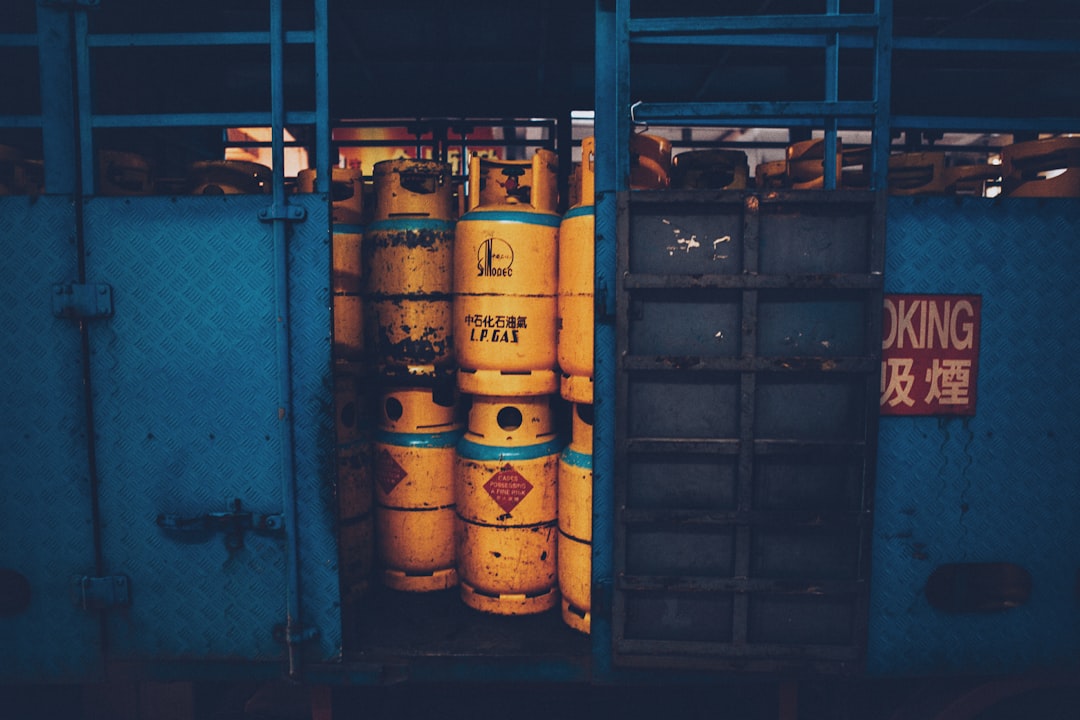Emergencies can strike at any moment. Maintenance emergencies in a manufacturing setup can not only halt the production process but also disrupt operations and pose serious safety risks. It's crucial to distinguish between routine maintenance issues and emergencies for an efficient response.
A maintenance emergency can be defined as an unexpected event that could threaten the property's safety, health, or value if not resolved immediately. Some common examples are a broken water line, fire, massive equipment malfunction, or power failure.
MicroMain, as an experienced provider of EAM and CMMS software solutions, realizes the significant role of maintenance emergency protocols. These protocols play pivotal roles in mitigating these disasters. They outline the specific steps to be taken in a maintenance emergency and include procedures to quickly evaluate the situation, isolate the danger, and mobilize the repair or replacement process.
Here at MicroMain, comprehensive and flexible CMMS (Computerized Maintenance Management System) and EAM (Enterprise Asset Management) can provide the crucial support needed to manage maintenance emergencies efficiently. These software solutions not only facilitate seamless reporting and tracking of maintenance issues but also aid in proactive preventive maintenance to minimize the occurrence of maintenance emergencies, maximizing ROA (Return on Asset) in the process.

In the following sections, we will explore the concept of maintenance emergencies in detail and outline the five critical maintenance emergency protocols essential in effectively managing these situations. Stay tuned to learn more about identifying a maintenance emergency, differentiating it from routine maintenance, and the crucial role of tenants and technology in emergency maintenance management.
Let's start this journey to enhance your understanding of maintenance emergencies and take your asset management to the next level.
Identifying a Maintenance Emergency
The first step in handling any maintenance issue effectively is accurately identifying whether it's a routine problem or an emergency. This distinction is critical in deciding the urgency of the response and the resources needed to address it.
Definition of a Maintenance Emergency
A maintenance emergency refers to an unforeseen incident that threatens the safety of people, property, or assets. This could range from a gas leak in an apartment building to a machine overheating in a manufacturing plant. These emergencies require immediate attention and intervention to mitigate the potential risks and damages.
In an industrial environment, emergencies could be triggered by human error, machine failure, or a lack of competence. For instance, a flood near electrical equipment or a fire breaking out due to a system malfunction would be classified as emergencies.
Differentiating Between Routine and Emergency Maintenance
While routine maintenance involves regular check-ups and minor repairs to keep your systems running smoothly, emergency maintenance is unscheduled maintenance necessitated by sudden breakdowns or failures. Knowing the difference is crucial to avoid unnecessary costs and to prioritize resources effectively.
For instance, a slow-draining sink or a broken cabinet door would fall under routine maintenance. These are issues that, while inconvenient, do not pose immediate threats to safety or property. On the other hand, a broken water line causing flooding or a gas leak would be classified as emergency maintenance requiring close attention.
The Contextual Nature of Maintenance Emergencies
What constitutes a maintenance emergency can vary depending on the context. For example, a broken air conditioning system may not be an emergency in a mild climate, but it could pose serious health risks in areas of extreme heat.
Similarly, the lack of hot water may be a mere inconvenience in a commercial office, but it would be an emergency in a residential building during winter. This contextual nature of maintenance emergencies underscores the need for comprehensive emergency protocols tailored to your environment's specific needs and risks.
At MicroMain, we understand the importance of accurate identification and efficient handling of maintenance emergencies. Our CMMS and EAM software solutions are designed to provide you with the tools and insights you need to manage these critical situations effectively. Our goal is to help you reduce the impact of these incidents on your operations, ensuring the safety of your assets and personnel.
Critical Maintenance Emergency Protocols
When a maintenance emergency strikes, it's crucial to have a clear and efficient response plan in place. Below, we outline five critical protocols from our maintenance emergency list that should be followed in various emergencies.
Protocol for Fire Emergencies
In the event of a fire, the first step is to ensure the safety of all personnel by evacuating the area immediately. Once everyone is safe, the fire department should be contacted.
Technicians should refrain from attempting to combat a large fire themselves. However, if it's a minor electrical fire, it can be handled using a suitable fire extinguisher. After the situation is under control, the root cause of the fire should be investigated, and necessary repairs or replacements should be carried out promptly to prevent future incidents.
Protocol for Flooding or Water Damage Emergencies
Active water leaks, such as those from a hot water tank or water supply line, are considered emergencies due to the potential for severe property damage. The first step is to shut off the water supply to the affected area. Then, any pooled water should be removed, and the area dried to prevent further damage. A professional should be contacted to repair the leak and assess the extent of the water damage.
Protocol for Gas Leak Emergencies
Gas leaks pose a significant health and safety risk. All individuals should evacuate the premises immediately if a gas leak is suspected. The gas supply should be shut off if it's safe. The gas company or a certified professional should be contacted to locate and repair the leak. Avoiding any actions that could ignite the gas, like using electronic devices or lighting matches.
Protocol for Power Loss Emergencies
A loss of power can severely disrupt operations. If the power outage is localized, check circuit breakers or fuses and reset if necessary. If the power loss is widespread, contact the utility company to report the outage and get an estimated restoration time. Meanwhile, any critical equipment should be switched to backup power if available.
Protocol for Extreme Temperature Emergencies

Extreme temperatures, whether too hot or too cold, can pose a risk to personnel and equipment. They should be repaired or replaced quickly if heating or cooling systems fail. The area should be evacuated if the temperature poses an immediate health risk.
Implementing these critical maintenance emergency protocols ensures a rapid and efficient response to maintenance emergencies, minimizing damage and downtime. At MicroMain, we're committed to effectively helping you manage these situations with our CMMS and EAM software solutions.
The Role of Tenants in Maintenance Emergencies
The tenant is a critical factor in the maintenance management process, mainly residential properties. As the primary user of the property, their role in identifying, reporting, and sometimes even addressing maintenance issues is vital.
Reporting Maintenance Emergencies Promptly
The first step in dealing with a maintenance emergency is identifying and reporting it. Tenants should know what constitutes a maintenance emergency, as discussed in our maintenance emergency list. As soon as an emergency is identified, tenants should promptly report it to the relevant authorities or property management. This will help minimize the damage and expedite the repair process.
Troubleshooting Minor Issues Before Reporting
While reporting emergencies promptly is essential, not all maintenance issues are emergencies. Tenants can help by troubleshooting minor issues before reporting them. For example, the tenant can often address a minor leak under the kitchen sink or a burnt-out light bulb without professional intervention. This can free up time and resources to attend to more critical issues.
Understanding the Importance of Accurate Reporting
The accuracy of the information provided when reporting a maintenance issue is crucial. Precise and detailed reporting can help the maintenance team diagnose the problem and plan the necessary repairs. For instance, in the event of a water leak, tenants should specify the exact location of the leak, its magnitude, and any consequential damage observed.
Tenants should never try to fix significant issues independently, as it could lead to further damage or even safety hazards. Instead, they should reach out to us at MicroMain. Our CMMS software can help manage these reports, ensuring that all maintenance requests are addressed promptly and efficiently.
In conclusion, the role of tenants in maintenance emergencies is crucial. By reporting promptly and accurately and troubleshooting minor issues where possible, they contribute significantly to effective maintenance management.
Leveraging Technology for Efficient Emergency Maintenance Management
When managing a maintenance emergency list, leveraging technology like Computerized Maintenance Management System (CMMS) and Enterprise Asset Management (EAM) software can help streamline processes and enhance efficiency. These solutions offer a structured approach to handling maintenance tasks, minimizing downtime, and maximizing productivity.
The Role of CMMS in Emergency Maintenance Management
A CMMS plays a critical role in emergency maintenance management. It helps automate and simplify maintenance processes. With a CMMS, you can receive automated maintenance requests, prioritize them based on urgency, and assign them to the appropriate technicians.
The software also ensures that these issues are addressed promptly. For instance, if a significant breakdown condition such as a malfunctioning elevator occurs, the CMMS can send electronic maintenance requests in real-time, ensuring quick response and minimizing downtime.
Moreover, the CMMS keeps a digital trail of all emergency maintenance incidents. This data provides valuable insights into potential weaknesses in your current maintenance strategy and helps make necessary improvements.
How EAM Software Streamlines Emergency Response
While a CMMS focuses on maintenance management, EAM software provides a holistic view of your assets. It covers everything from procurement to disposal and all stages, ensuring optimum asset performance and lifespan.
EAM software includes features like contract management, fleet management, schematics, warranty tracking, and energy monitoring, which are not typically found in a CMMS. For instance, the energy monitoring feature helps identify energy-saving opportunities, reduce operational costs, and contribute to sustainability goals.
The Benefits of Using MicroMain's CMMS and EAM Software
At MicroMain, we provide robust, flexible, and user-friendly CMMS and EAM solutions designed to meet the unique needs of your business. Our software helps you manage your maintenance operations effectively, reducing unplanned downtime, cutting maintenance costs, and improving inventory management.
Our CMMS software comes with a work order request portal, which simplifies the process of reporting maintenance issues. It also offers automated response maintenance, ensuring immediate attention to critical problems.
Our EAM software, on the other hand, gives you total control over your assets, providing insights into their lifecycle and performance. It also includes industry-specific apps tailored to meet the unique needs of different sectors.
In short, our software solutions help you manage your maintenance emergency list and build an effective maintenance strategy that enhances productivity and reduces costs.
Conclusion
The Importance of Being Prepared for Maintenance Emergencies
In conclusion, your ability to swiftly and effectively respond to maintenance emergencies can significantly impact the health and safety of your tenants, the integrity of your assets, and, ultimately, your business's bottom line. A well-defined maintenance emergency list, clear protocols, and the ability to differentiate between routine and emergency maintenance are all critical in ensuring that emergencies are addressed promptly and effectively.
Emergencies can occur at any time, so it's vital to have an emergency plan in place. This plan should include a comprehensive maintenance emergency list and clear instructions on handling each type of emergency. Everyone involved, from maintenance staff to tenants, should be familiar with this plan to ensure a swift and coordinated response when emergencies arise.
How MicroMain Can Help in Efficient Maintenance Management
At MicroMain, we understand the challenges that come with managing maintenance emergencies. That's why our CMMS and EAM software solutions are designed to help you effectively manage and respond to maintenance emergencies.
Our software allows you to create and manage a comprehensive maintenance emergency list, schedule preventative maintenance tasks, and keep a digital trail of emergency work orders. This makes planning, scheduling, and executing preventive maintenance easier, so you never need to perform emergency maintenance.
Additionally, our software can be easily configured to work effectively in the most unique situations, making it ideal for various industries. From airports and banks to farms and zoos, our software is trusted by organizations across the globe to manage assets and maintain facilities.
A robust emergency maintenance protocol backed by a powerful and flexible CMMS and EAM software like ours at MicroMain can be the difference between a minor hiccup and a major catastrophe.
For more information about how our software solutions can help you manage your maintenance operations more effectively, check out our CMMS and EAM software solutions.

At MicroMain, we're here to help you manage your maintenance operations smoothly and effectively. Less hassle, more control - that's the MicroMain way.
 For immediate assistance, please call us at (512) 328-3235
For immediate assistance, please call us at (512) 328-3235







